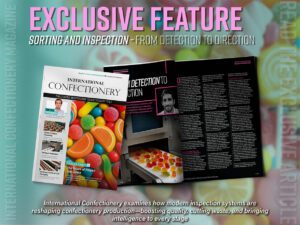In an industry where speed and quality go together like crisps and salt, snack and confectionery manufacturers face the constant challenge of keeping up with consumer demand without sacrificing product integrity. Snacking continues to become more popular globally. It is even predicted that by the year 2030, global sales of savoury snacks could reach a value of USD386.8 billion[1]. It’s easy to see that the pressure to deliver a diverse range of high-quality products at speed has never been greater. Rob Stevens, Market Manager at Mettler-Toledo Product Inspection explores how manufacturers can overcome production challenges in high-speed snack and confectionery applications without compromising quality.
Challenges in High-Speed Production
High-speed snack and confectionery production poses several challenges, particularly in product handling and rejection. When products are processed at high speeds, they are more susceptible to damage or misalignment, leading to increased rejection rates. Handling delicate items or products with specific packaging requirements, like flow-wrapped goods, becomes more complex as speed increases, elevating the risk of product rejection and waste.
Weight Challenges
Accurate weighing is further complicated by the sealed edges of flow wraps, which can cause handling and sorting issues, and the need for stricter tolerances with smaller, lighter products. Advanced dynamic checkweighers incorporating FlashCell™ technology from Mettler-Toledo help solve this issue by effectively handling products with brief weighing times. They also offer enhanced accuracy and reliable handling, providing consistent weight measurements and product quality, even at speeds of up to 800 products per minute.
Contaminant Detection
Product purity is hugely important in snacks and confectionery and can be challenging due to the high speed and variety of products on the production line. Effective contaminant detection is essential for both unpacked and packed products to maintain consumer safety and brand integrity, and reduce the risk of product recalls. Manufacturers can use a combination of metal detection and x-ray inspection technologies to meet these needs efficiently.
Metal Detection and X-ray Inspection
Metal detectors specialise in detecting metallic contaminants, such as ferrous, non-ferrous and stainless steel particles. They work by generating an electromagnetic field and identifying metal particles that disrupt this field. Metal detection systems can be used at various points on the production line, from the start of production to inspect raw materials, to the end of the line after primary packaging. However, the most popular insertion point in snack foods and confectionery manufacturing is just prior to packaging. Products are weighed using multi-head weighing technology, then drop through the metal detector and into the bag which is then sealed. This technology is ideal for high-speed production environments where rapid, accurate detection of metal contaminants is needed.
Inspection at this point minimises the risk of metal contaminants in the finished product and overcomes any packaging material limitations that may exist at primary or secondary packaging stage. Productivity can be further boosted by technology, such as an Automatic Test System (ATS) from Mettler-Toledo which improves test accuracy and reduces testing duration, whilst also reducing the number of operators required to perform the test from two to one. From a total cost of ownership perspective, metal detection at this Critical Control Point (CCP) is an ideal choice.
In both horizontal and vertical applications, metal detection systems provide efficient and accurate results. Vertical inspection setups, particularly with the use of throat metal detectors in VFFS (Vertical Form Fill Seal) applications, are highly effective for inspecting products like snack foods and crisps. These detectors are installed between the weigher and the bagging machine, allowing free-falling products to be inspected as they move through the system. This method means that foreign body contaminants are identified before packaging, which is especially beneficial in high-speed production environments.
X-ray inspection systems are ideal for detecting a wide range of contaminants in packed products either at the primary or the secondary packaging stage. For x-ray inspection, this may include contaminants such as glass, metal, mineral stones, dense plastics, rubber compounds and even agglomerates – an issue commonly faced by crisp manufacturers. Agglomerates, or clumps of seasoning powder, can form during the manufacturing process and affect product quality by altering taste, texture and appearance.
[1] https://www.statista.com/statistics/1196800/global-savory-snack-market-size/
Read more latest industry news and developments in our free to download magazine.
Never miss a story… Follow us on:
LinkedIn: International Confectionery
YouTube: @ConfectioneryTV
Media contact
Joseph Clarke
Editor, International Confectionery
Tel: +44 (0) 1622 823 920
Email: [email protected]








